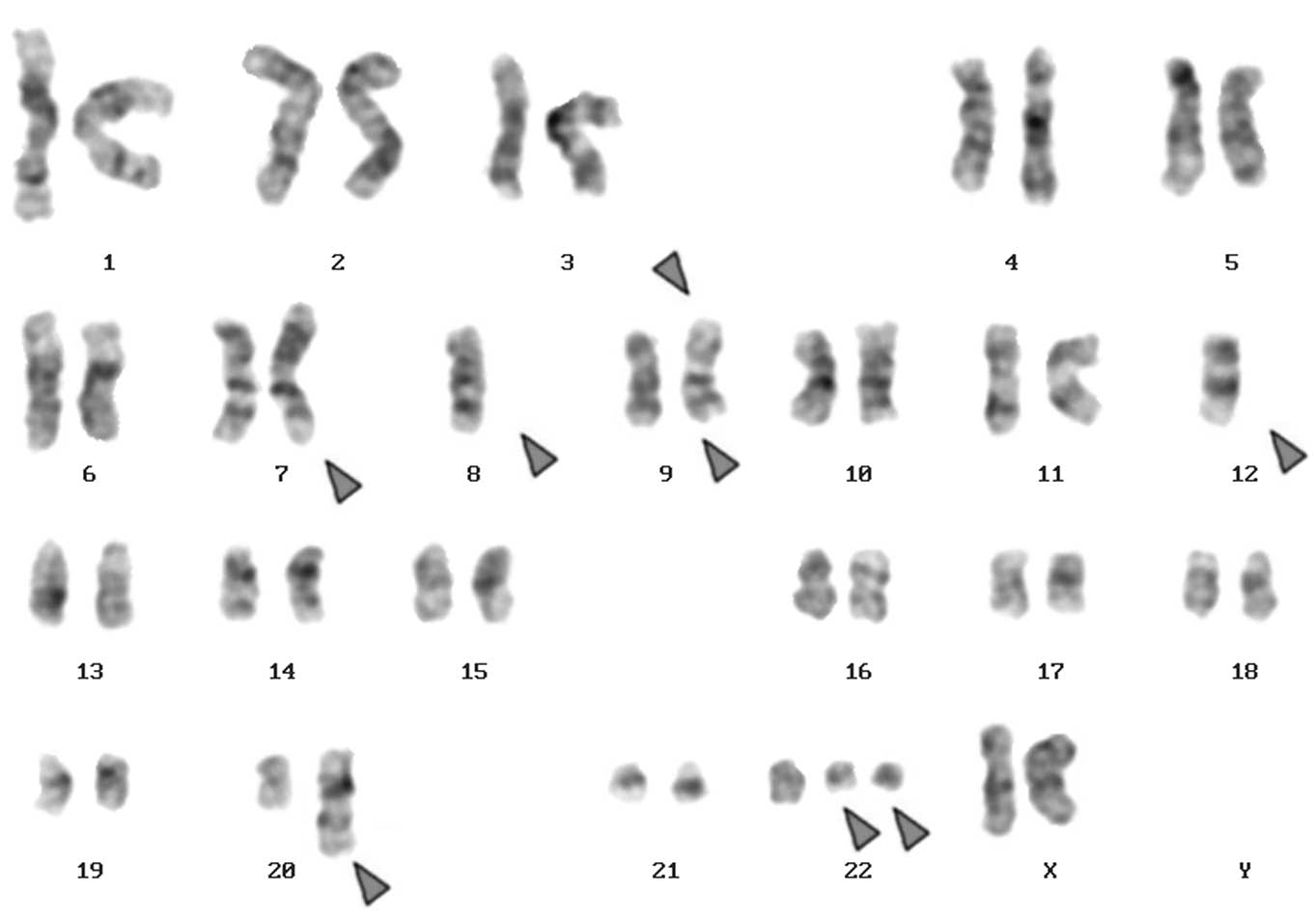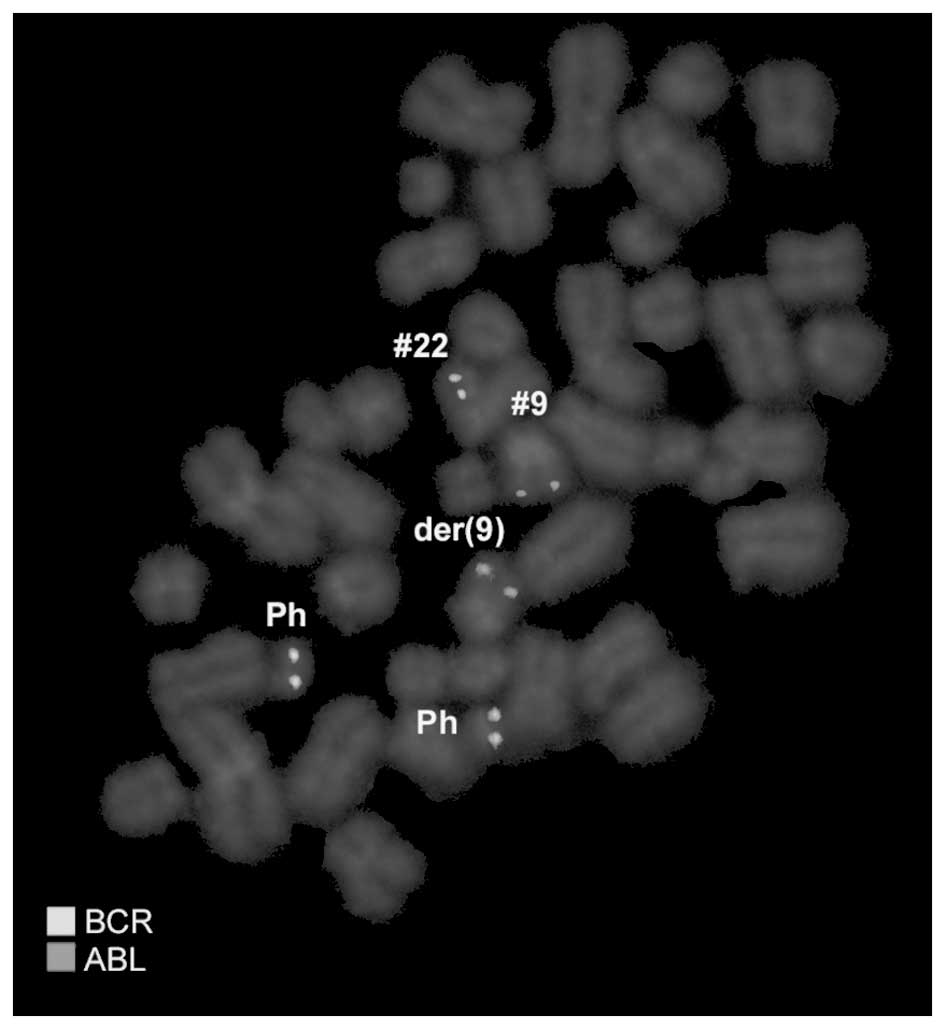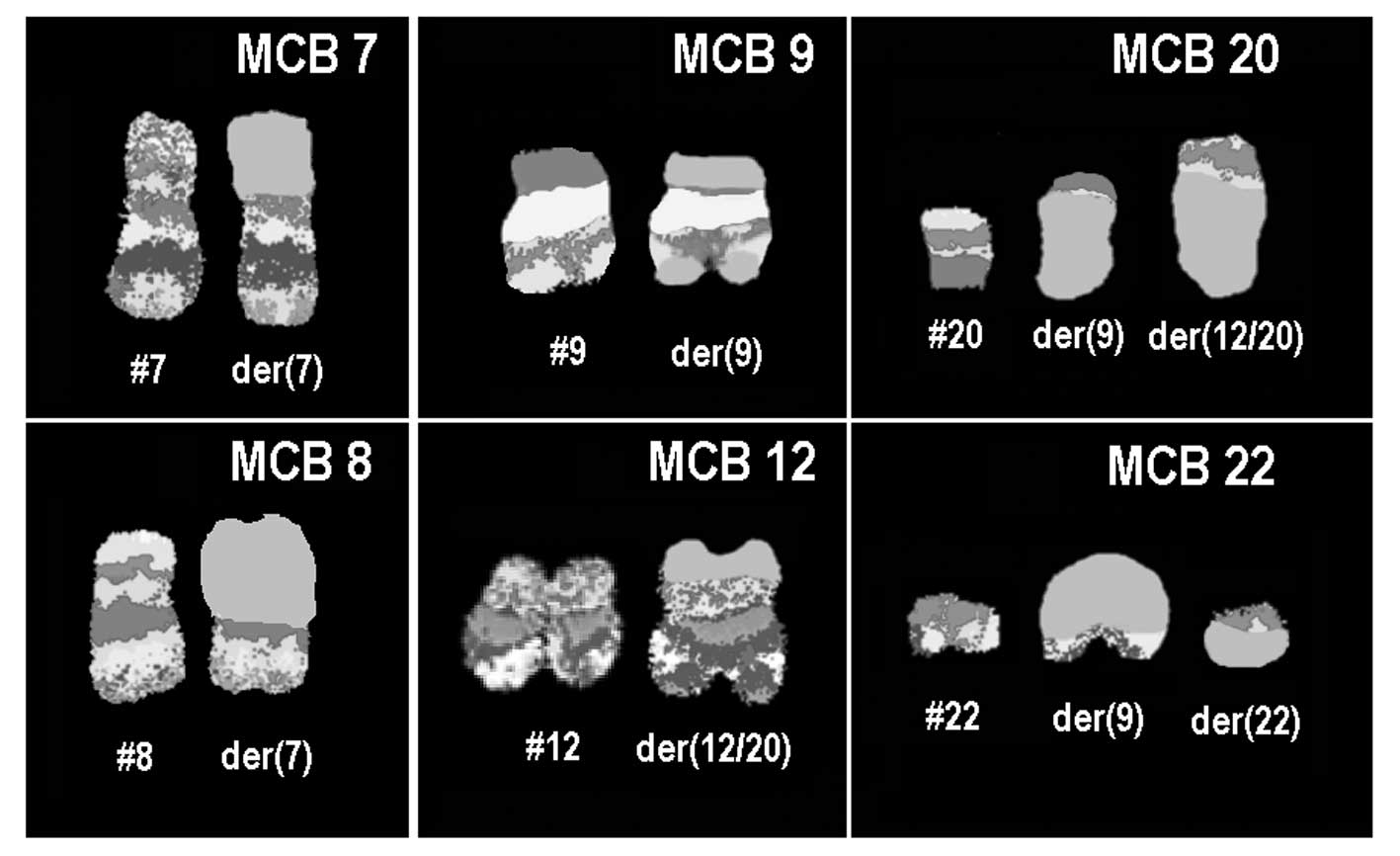A novel cytogenetic abnormality t(7;8)(p11.2:q11.2) and a four-way Philadelphia translocation in an imatinib mesylate‑resistant chronic myeloid leukemia patient
- Authors:
- Published online on: November 21, 2012 https://doi.org/10.3892/ol.2012.1037
- Pages: 617-620
Abstract
Introduction
Chronic myelogenous leukemia (CML) is a myeloproliferative disease characterized by the Philadelphia (Ph) chromosome. This chromosome is created by a reciprocal t(9:22) translocation which transfers the Abelson (ABL) oncogene on chromosome 9 to the breakpoint cluster region (BCR) of chromosome 22, resulting in the formation of a fused BCR/ABL gene (1). BCR/ABL produces an abnormal tyrosine kinase that causes aberrant myelopoiesis identified in CML. Variant Ph chromosome translocations involving one or more chromosome regions in addition to chromosomes 9 and 22 have been identified in 5–10% of CML patients (2). In these variants, four-way Ph chromosome translocations are rare (3). The prognostic significance of variant Ph chromosome CML remains unclear.
The progression of CML from the chronic phase (CP) to blast crisis (BC) is frequently associated with non-random secondary chromosomal aberrations, including +8, i(17q), +19 and an extra Ph chromosome (4).
Since tyrosine kinase activity is required for the transforming function of the BCR/ABL fusion protein, imatinib, a specific inhibitor of the kinase, is an effective treatment for CML patients. The 5-year estimated overall survival rate for patients who receive imatinib as initial therapy is 89%. This rate is higher than those reported in previous studies of CML treatment and only 7% of all patients progressed to the accelerated phase (AP) or BC (5). In a previous study, deletions on the derivative chromosome 9 [der(9)] were identified at a higher frequency in patients with variant Ph translocations than in those with classic Ph (45 and 17%, respectively) (6).
In the present study, a novel case of a Ph chromosome-positive CML in BC was identified, with a four-way rearrangement involving five chromosomal regions, 9p21, 9q34, 12p13.3, 20q11.2 and 22q11.2, an unbalanced translocation der(7)t(7;8) (p11.2;q11.2), deletions of ABL and argininosuccinate synthetase (ASS) genes at 9q34 on der(9), partial monosomies 8, 12 and an additional Ph chromosome. In addition, immunopheno-type analysis indicated biphenotypic leukemia.
Materials and methods
Case report
In April 2011, a 22-year-old female presented with a white blood cell count (WBC) of 97×109 cells/l (neutrophils, 21; lymphocytes, 73; eosinophiles, 4; monocytes, 1; and basophiles, 1%). The platelet count was 268×109 cells/l and the hemoglobin level was 9.1 g/dl. Physical examination revealed splenomegaly and weight loss was noted. Chromosome analysis using banding cytogenetics demonstrated a karyotype consistent with clinical diagnosis of a CML in CP. The patient was treated daily with Zyloric (300 mg) and hydroxyurea (500 mg) for four days. LDH was 1860 U/l (normal, <460 U/l) and serum alkaline phosphase was 348 U/l (normal, <232 U/l). In September 2011, the patient presented for the second time with a WBC count of 132.4×109 cells/l (neutrophils, 1; lymphocytes, 40; and immature cells, 52%). Platelet count was 22×109/l and the hemoglobin level was 10 g/dl. Imatinib mesylate (400 mg/day) was administered for five months and following this period the described symptoms were not observed. In October 2011, the patient died for unknown reasons under treatment.
Chromosome analysis
Chromosome analysis using GTG-banding was performed according to standard procedures (7) prior to chemotherapeutic treatment. A total of 20 metaphase cells derived from unstimulated bone marrow culture were analyzed. Karyotypes are described according to the International System for Human Cytogenetic Nomenclature (8).
Molecular cytogenetics
Fluorescence in situ hybridization (FISH) using LSI BCR/ABL+9q34 three color dual fusion translocation probe (Abbott Molecular/Vysis, Des Plaines, IL, USA) and chromosome enumeration probe (CEP) for chromosome 9 (Abbott Molecular/Vysis) were applied according to the manufacturer’s instructions together with a whole chromosome painting (WCP) probe for chromosomes 7, 8, 9, 12, 20 and 22 (MetaSystems, Altlussheim, Germany) (7). FISH using the corresponding chromosome specific array-proven multicolor banding (aMCB) probe sets based on microdis-section derived region-specific libraries was performed as previously described (7). A minimum of 20 metaphase spreads were analyzed, using a fluorescence microscope (AxioImager.Z1 mot, Carl Zeiss Ltd., Hertfordshire, UK) equipped with appropriate filter sets to discriminate between a maximum of five fluorochromes and the counterstain DAPI (4′,6-diamino-2-phenylindole). Image capture and processing were performed using the ISIS imaging system (MetaSystems).
Reverse transcription polymerase chain reaction (RT-PCR) for BCR/ABL fusion transcripts
Total RNA was extracted from the diagnostic peripheral blood sample using the InviTrap RNA kit (Invitek GmbH, Berlin, Germany) according to the manufacturer’s instructions. cDNA was prepared from 5μg total RNA with the Genequality BCR-ABL kit (AB Analitica, Padova, Italy) according to the manufacturer’s instructions.
Flow cytometry immunophenotyping
Immunophenotyping of leukemic blasts was performed as previously described (7).
DNA sequencing
Detection of BCR/ABL mutation domain was performed using previously described primers (9).
Results
Karyotyping was performed prior to and following chemotherapy treatment. Prior to chemotherapy, the karytype was identified as 46,XX,t(9;22)[20] and following chemotherapy was 45,XX,der(7)t(7;8),-8,der(9)t(20;9;22),-12,der(12)(12;20),+der(22)t(9;22)×2[13]/45,XX,der(7)t(7;8),-8,t(9;22) [7] (Fig. 1A). Number of cells is provided in square brackets. Dual-color FISH using a probe specific for BCR, ABL and ASS genes revealed two typical Ph chromosomes with the BCR/ABL fusion gene on the der(22). On the der(9), ABL and ASS genes at 9q34 were deleted and the BCR gene was present (Fig. 2). Chromosomes 7, 8, 9, 12, 20 and 22 were observed using WCP and/or CEP probes (data not shown). RT-PCR confirmed the presence of the BCR-ABL fusion (b3a2 transcript) revealing a major M-BCR transcript, most often identified in CML (data not shown). Finally, aMCB using probes for the corresponding chromosomes was performed as previously reported (7) (Fig. 3). The following final karyotype was determined: 45,XX,der(7)t(7;8)(p11.2;q11.2),-8,der(9) (20qter→20q11.2::9p21→9q34::22q11.2→22qter),-12,der(12) (20pter→20q11.2::12p13.3→12q24.3::12q24.3→12q15∼21.1), +der(22)t(9;22)(q34;q11.2)×2[13]/45,XX, der(7)t(7;8) (p11.2;q11.2),-8,t(9;22)(q34;q11.2)[7]. Number of cells is provided in square brackets.
Immunophenotypic analysis of peripheral blood demonstrated that the abnormal cell population positivity reacted with antibodies against CD45 (95%), HLADr (79%), CD19 (73%), CD34 (29%), CD10 (78%), CD33 (41%), CD18 (70%), CD32 (70%), CD22 (40%), CD123 (61%), CD20 (40%), CD235a (63%), CD117 (30%), CD38 (59%) and CD15 (60%). The cell population negativity reacted with additional antibodies used. Expression profiles of multilineages indicated that the patient had biphenotypic leukemia (10).
DNA sequencing of the BCR/ABL kinase domain identified no mutations.
Discussion
In the present study, a novel case of Ph chromosome-positive CML in BC with a four-way rearrangement was observed, including five chromosomal regions, 9p21, 9q34, 12p13.3, 20q11.2, 22q11.2, an unbalanced translocation t(7;8) (p11.2;q11.2), deletions of ABL and ASS genes on der(9), monosomies 8, 12 and an additional Ph chromosome. To the best of our knowledge, these chromosomal aberrations, particularly t(7;8)(p11.2;q11.2) have not been previously observed in CML (11).
Four-way Ph translocation is extremely rare and only anecdotal cases have been described in the imatinib era. In the most recent study of CML, only 3/500 patients receiving imatinib mesylate as a frontline therapy were observed to have a four-way translocation (3).
The mechanism of development of this complex rearrangement may include a primary standard t(9;22), followed by a subsequent three-way translocation affecting chromosomes 12, 20 and the der(9). The fusion BCR/ABL signal was identified on der(22) and chromosome 22 had not rearranged with chromosome 20 or 12. These observations are consistent with a common two-step rearrangement process (12). Therefore, an inherent implication of the two-step mechanism is that variant translocations may be associated with a poorer prognosis (13).
Resistance to chemotherapy occurs as a result of increased expression of the BCR-ABL kinase from genomic amplification, clonal chromosomal evolution or mutations in the ABL kinase of the BCR-ABL gene, affecting drug interaction or kinase activity (14).
Submicroscopic ASS gene deletions in fused chromosome 9 were previously reported to be important for development of shortened CP and decreased overall survival, associated with a poor prognosis and response to interferon and imatinib mesylate (15,16).
Leukemias of ambiguous lineage are uncommon, representing ∼4% of all acute leukemias, and frequently demonstrate an aggressive disease course, with mean survival rates less than those of leukemias derived from a single-cell lineage (17). No single chromosome abnormality is unique to biphenotypic leukemia (18). In the present study, a complex cytogenetic abnormality was identified using conventional and molecular cytogenetics. Therefore, we hypothesize that leukemias of ambiguous lineage associated with cytogenetic abnormalities indicate a poorer prognosis than those without demonstrable abnormalities.
Recurrent chromosomal deletions identified in sporadic types of cancer often contain tumor suppressor genes (TSGs). TSGs function in signaling networks that protect against tumor initiation and progression and are inactivated by deletions, point mutations or promoter hypermethylation (19). For example, TCR β (7p15) (20); DLC-1 (8p21.3–22), FEZ1 (8p22) and LTPS (8p23) (21); p16INK4a, p14ARF and p15INK4b (9p21) (22); and the leukemogenesis-relevent ETV6 gene (12p)(23).
In conclusion, the present study reports a novel case of a Ph chromosome-positive CML in BC with a four-way Ph trans-location. The translocation is likely to result from a two-step mechanism. In addition to an unbalanced translocation der(7) t(7;8)(p11.2;q11.2), multiple partial chromosomal regions were deleted, partial monosomies 8, 12 and an additional Ph chromosome were identified. Immunophenotyping indicated that the patient had biphenotypic leukemia. These observations represent an adverse prognosis in CML. The patient died under treatment one month after diagnosis.
Acknowledgements
The authors thank Professor I. Othman, the Director General of the Atomic Energy Commission of SYRIA (AECS) and Dr N. Mirali, Head of the Molecular Biology and Biotechnology Department, for their support. The present study was supported by the AECS, and in part by the DAAD, Stefan-Morsch-Stiftung and the Monika-Kutzner-Stiftung.
References
|
Sawyers CL: Chronic myeloid leukemia. N Engl J Med. 340:1330–1340. 1999. View Article : Google Scholar : PubMed/NCBI | |
|
Johansson B, Fioretos T and Mitelman F: Cytogenetic and molecular genetic evolution of chronic myeloid leukemia. Acta Haematol. 107:76–94. 2002. View Article : Google Scholar : PubMed/NCBI | |
|
Adriana Z and Al Bahar S: Novel four-way Ph translocation t(9;22;7;1)(q34;q11;q22;p13) in a chronic myeloid leukemia patient receiving tyrosine kinase inhibitor therapy. Int J Hematol. 95:315–319. 2012. View Article : Google Scholar : PubMed/NCBI | |
|
Sandberg AA: The Chromosomes in Human Cancer and Leukemia. 2nd edition. Elsevier Science; New York, NY: pp. 151–172. 1990 | |
|
Druker BJ, Guilhot F, O’Brien SG, Gathmann I, Kantarjian H, Gattermann N, et al: Five-year follow-up of patients receiving imatinib for chronic myeloid leukemia. N Engl J Med. 355:2408–2417. 2006.PubMed/NCBI | |
|
Reid A, Gribble SM, Huntly BJ, Andrews KM, Campbell L, Grace CD, Wood ME, Green AR and Nacheva EP: Variant Philadelphia translocations in chronic myeloid leukaemia can mimic typical blast crisis chromosome abnormalities or classic t(9;22): a report of two cases. Br J Haematol. 113:439–442. 2001. View Article : Google Scholar | |
|
Al-Achkar W, Wafa A, Klein E and Aljapawe A: Biclonal myelodysplastic syndrome involving six chromosomes and monoallelic loss of RB1 - A rare case. Mol Cytogenet. 4:162011. View Article : Google Scholar : PubMed/NCBI | |
|
Shaffer L, Slovak M and Cambell L: ISCN (2009): An International System for Human Cytogenetic Nomenclature. 1st edition. S. Karger AG; Basel: 2009 | |
|
Chien JH, Tang JL, Chen RL, Li CC and Lee CP: Detection of BCR-ABL gene mutations in Philadelphia chromosome positive leukemia patients resistant to STI-571 cancer therapy. Leuk Res. 32:1724–1734. 2008. View Article : Google Scholar : PubMed/NCBI | |
|
Rothe G and Schmitz G: Consensus protocol for the flow cyto-metric immunophenotyping of hematopoietic malignancies. Working Group on Flow Cytometry and Image Analysis. Leukemia. 10:877–895. 1996.PubMed/NCBI | |
|
Mitelman F, Johansson B and Mertens F: Mitelman Database of Chromosome Aberrations in Cancer. http://cgap.nci.nih.gov/Chromosomes/Mitelman. Accessed October 3, 2012. | |
|
Reid AG, Huntly BJP, Grace C, Green AR and Nacheva EP: Survival implications of molecular heterogeneity in variant Philadelphia-positive chronic myeloid leukaemia. Br J Haematol. 121:419–427. 2003. View Article : Google Scholar : PubMed/NCBI | |
|
Bennour A, Sennana H, Laatiri MA, Khelif A and Saad A: A masked BCR/ABL rearrangement in a case of chronic myeloid leukemia with translocation t(3;9)(p14;q34). Cancer Genet Cytogenet. 181:72–74. 2008. View Article : Google Scholar : PubMed/NCBI | |
|
Hochhaus A, Kreil S, Corbin AS, La Rosée P, Müller MC, Lahaye T, Hanfstein B, Schoch C, Cross NCP, Berger U, Gschaidmeier H, Druker BJ and Hehlmann R: Molecular and chromosomal mechanisms of resistance to imatinib (STI571) therapy. Leukemia. 16:2190–2196. 2002. View Article : Google Scholar : PubMed/NCBI | |
|
Bacher U, Schnitter S, Kern W, Hiddemann W, Haferlach T and Schoch C: The incidence of submicroscopic deletions in reciprocal translocations is similar in acute myeloid leukemia, BCR-ABL positive acute lymphoblastic leukemia and chronic myeloid leukemia. Haematologica. 90:558–559. 2005. | |
|
Bennour A, Sennana H, Laatiri MA, Elloumi M, Khelif A and Saad A: Molecular cytogenetic characterization of variant Philadelphia translocations in chronic myeloid leukemia: genesis and deletion of derivative chromosome 9. Cancer Genet Cytogenet. 194:30–37. 2009. View Article : Google Scholar | |
|
Brunning RD, Matutes E, Borowitz M, et al: Acute leukaemias of ambiguous lineage. World Health Organization Classification of Tumours: Pathology and Genetics of Tumours of Haemopoietic and Lymphoid Tissues. Jaffe ES, Harris NL, Stein H and Vardiman JW: IARC Press; Lyon, France: pp. 106–107. 2001 | |
|
Carbonell F, Swansbury J, Min T, Matutes E, Farahat N, Buccheri V, Morilla R, Secker-Walker L and Catovsky D: Cytogenetic findings in acute biphenotypic leukaemia. Leukemia. 10:1283–1287. 1996.PubMed/NCBI | |
|
Downward J: Targeting RAS signalling pathways in cancer therapy. Nat Rev Cancer. 3:11–22. 2003. View Article : Google Scholar : PubMed/NCBI | |
|
Wlodarska I, Martin-Garcia N, Achten R, De Wolf-Peeters C, Pauwels P, Tulliez M, de Mascarel A, Briere J, Patey M, Hagelmeijer A and Gaulard P: Fluorescence in situ hybridization study of chromosome 7 aberrations in hepatosplenic T-cell lymphoma: isochromosome 7q as a common abnormality accumulating in forms with features of cytologic progression. Genes Chromosomes Cancer. 33:243–251. 2002. View Article : Google Scholar | |
|
Qin LX: Chromosomal aberrations related to metastasis of human solid tumors. World J Gastroenterol. 8:769–776. 2002.PubMed/NCBI | |
|
Mancini M, Scappaticci D, Cimino G, Nanni M, Derme V, Elia L, Tafuri A, Vignetti M, Vitale A, Cuneo A, Castoldi G, Saglio G, Pane F, Mecucci C, Camera A, Specchia G, Tedeschi A, Di Raimondo F, Fioritoni G, Fabbiano F, Marmont F, Ferrara F, Cascavilla N, Todeschini G, Nobile F, Kropp MG, Leoni P, Tabilio A, Luppi M, Annino L, Mandelli F and Foà R: A comprehensive genetic classification of adult acute lymphoblastic leukemia (ALL): analysis of the GIMEMA 0496 protocol. Blood. 105:3434–3441. 2005. View Article : Google Scholar : PubMed/NCBI | |
|
Andreasson P, Johansson B, Arheden K, Billstrom R, Mitelman F and Hoglund M: Deletions of CDKN1B and ETV6 in acute myeloid leukemia and myelodysplastic syndromes without cytogenetic evidence of 12p abnormalities. Genes Chromosomes Cancer. 19:77–83. 1997. View Article : Google Scholar : PubMed/NCBI |












